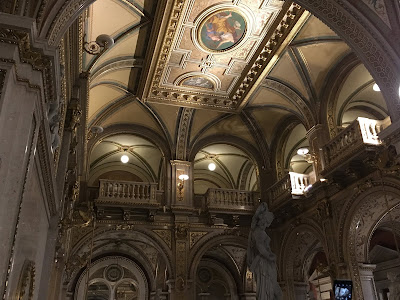It was fun to compare to the tour we had at La Scala Opera House in Milan several years ago. The Vienna opera house is larger, but similar in many ways. Both have small display screens in front of each seat where the language of the opera can be translated into other languages for the audience member. Both are decorated in Royal red and gold. Both have a royal box.
It has five tiers of seating, including two different 'standing only' areas for 3 and 4 euros. The sales for these seats opens just 18 minutes before the show begins.
I was particularly impressed with the scale of the stage and backstage area. The guide explained that they put on 50 different shows during a 10 months season, often with 5 different shows in one week. The crew would set up one stage for a morning rehearsal, then replace it with another stage for a different night time performance. There were over 100 separate pulley systems for backdrops and curtains, etc.
When looking at the stage, the blue pole visible on the right is the same depth back from the front of the stage as the back of the audience seating. As you can see, the backstage goes much further back than that. The entire hole under the stage is over 20 ft deep and can hold a whole other stage set to be changed out. This is also true to the side of the stage.
While we were sitting there listening to the guide (about 15 mins), the stage crew completely installed the springy stage top for a ballet that evening. Like a giant jigsaw puzzle.











No comments:
Post a Comment